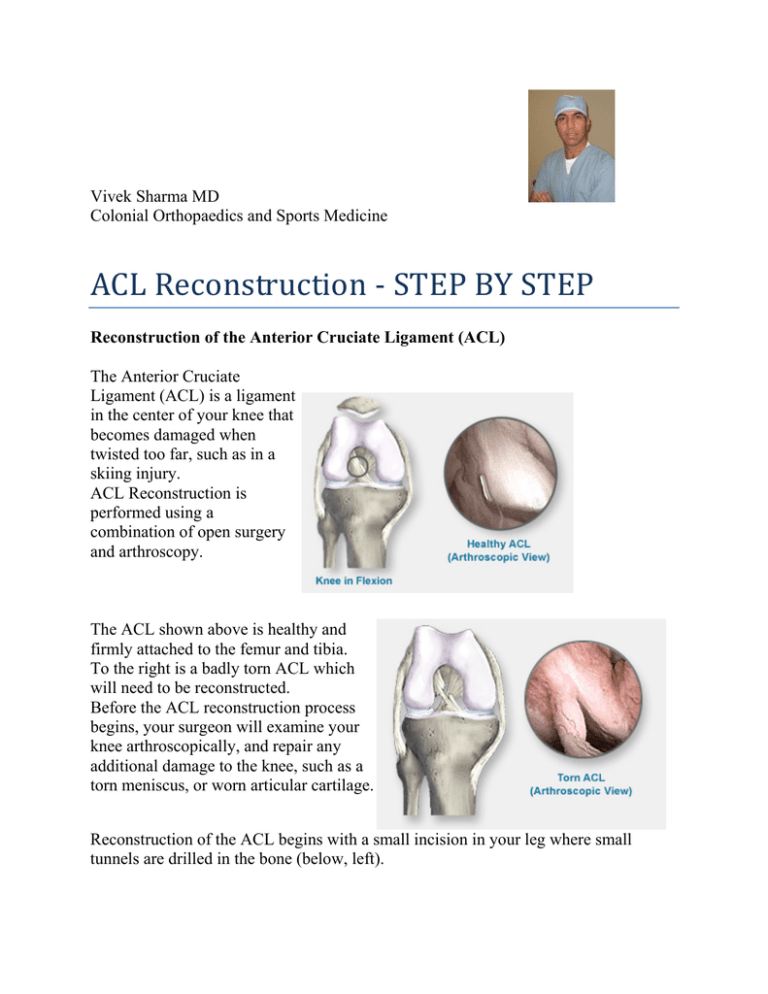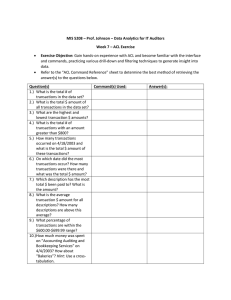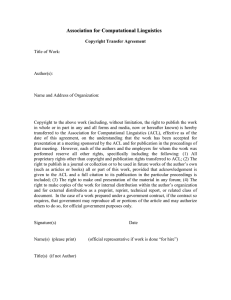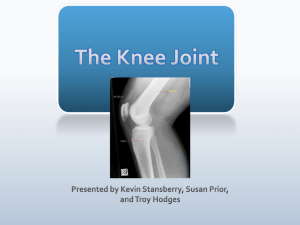ACL Reconstruction ‐ STEP BY STEP
advertisement

Vivek Sharma MD Colonial Orthopaedics and Sports Medicine ACL Reconstruction ‐ STEP BY STEP Reconstruction of the Anterior Cruciate Ligament (ACL) The Anterior Cruciate Ligament (ACL) is a ligament in the center of your knee that becomes damaged when twisted too far, such as in a skiing injury. ACL Reconstruction is performed using a combination of open surgery and arthroscopy. The ACL shown above is healthy and firmly attached to the femur and tibia. To the right is a badly torn ACL which will need to be reconstructed. Before the ACL reconstruction process begins, your surgeon will examine your knee arthroscopically, and repair any additional damage to the knee, such as a torn meniscus, or worn articular cartilage. Reconstruction of the ACL begins with a small incision in your leg where small tunnels are drilled in the bone (below, left). Next your new ACL is brought through these tunnels, and then secured. As healing occurs, the bone tunnels fill in to secure the tendon. The following pictures will demonstrate an ACL (Anterior Cruciate Ligament) reconstruction using the central third of the patella tendon. The surgery was performed on the right knee. 1. The inflow cannula, which brings the fluid into the joint so that the knee may be visualized, is seen in this picture. The patella is at the top of the screen and the trochlear groove of the femur at the bottom. The width of the tube is approximately 4 mm (1 inch = 25.4 mm). 2. The apparently normal meniscus is viewed in the center of the image. The femur is above the meniscal cartilage and the tibia is below it. A probe is inserted to inspect the meniscal cartilage. 3. The normal ACL is a taut rope-like structure which goes from the femur to the tibia. Probing of this ACL indicates that it is lax and frayed. This indicates a functionally incompetent ACL (torn ACL). 4. To reconstruct the ACL, it is necessary to remove all of the existing damaged ACL. This is done with a motorized device which is called a shaver. 5. In some patients, the "notch" where the ACL is located is extremely narrow. If the notch is not widened, then the newly reconstructed ACL may be at risk for rerupture. To decrease the probability of injury to the newly reconstructed ACL, the notch may be widened using a burr. 6. At this point, attention is directed to the patella tendon. Incisions are made at the inferior pole of the patella and at the tibial tubercle. Each incision is approximately 1.5 inches in length. 7. After making the skin incisions, the tendon is identified, and the central third is harvested with a bone block at each end of the tendon. Initially, the tendon is removed from the tibial tubercle area. The graft is then passed beneath the skin and retrieved from the superior incision. Harvesting is completed. 8. The graft then has sutures placed through the bone blocks. 9. Attention is then directed to the arthroscopic part of the procedure. The tibial drill guide is positioned on the tibia. 10. The guide wire is then drilled into the tibia, exiting inside the joint. 11. The tibial drill hole is placed. 12. The endoscopic femoral drill guide is then passed through the tibial drill hole. 13. The guide is then positioned on the back of the femur. 14. The femoral guide wire is then placed, the femoral guide is removed and the femoral drill is used to place a hole in the femur. 15. After drilling, the hole is inspected. 16. The graft is then placed through the tibia, through the knee joint, and into the femoral drill hole. 17. For the graft to heal, blood vessels must grow into the reconstructed ACL. To hold the graft in place, a screw is inserted into the femoral drill hole. This particular screw is a bioabsorbable screw. 18. A second screw is inserted into the tibia to hold that part of the reconstruction in place. Following this, the reconstructed ACL is inspected. Unlike the picture of the torn ACL, the reconstructed ACL is a rigid rope-like structure that provides stability to the joint. 19. At this point the procedure is finished, the incisions are closed, and the outpatient surgical procedure is completed.





